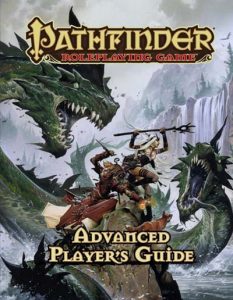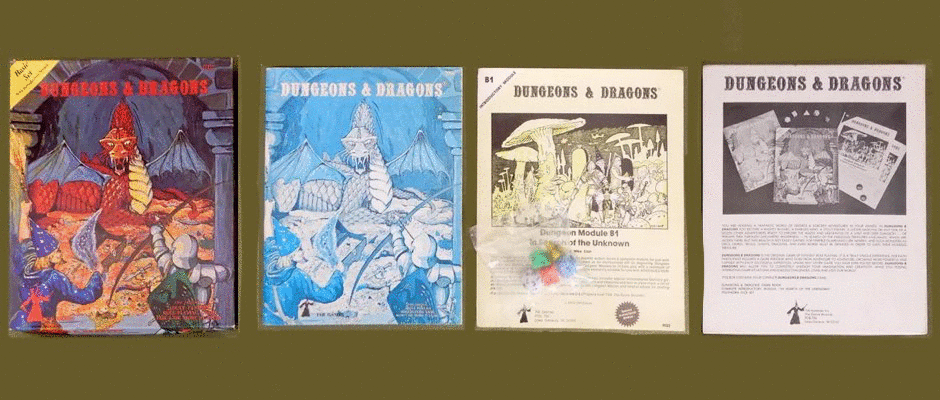
This is the closest equivalent to D&D’s Players Handbook II, which I really miss from the 3.5e days. Within APG‘s 336 pages are a slew of ideas to implement into any Pathfinder game. Originally, I bought this for the potential options the Witch and Cavalier classes offered. Additional Spells and Feats were a given but there’s much more.
I’m going to break it down as I did with GMG yet I hope to be succinct.
Chapter 1 shows new possible options to shake up the traditional Core races in the game via racial traits and favored classes. For example, Dwarves can exchange the greed trait (+2 on Appraise rolls with precious gems and metals) for lorekeeper (+2 on History rolls when it pertains to dwarves and their enemies). Dwarven Fighters receive an extra +1 to their CMD/CMB against trip and bull rush attacks instead of the extra hit point/level. The point is there are options to help certain combinations make more sense, or against stereotypes.
Chapter 2 was the major reason for buying this, six new Core Classes. I recently re-read them and my reasons on why I don’t allow four of them stands but with elaborate reasons. I’ll start with the two I like.
- Cavalier: A more martial class than the Fighter since these warriors would more likely be from the upper social classes. I miss the Knight from PHB II because it was the best counter to the Barbarian (d12 hit points, always Lawful). Paizo going with Cavalier might be for two reasons: avoid upsetting WOTC even though Knights are not part of 5e; mounted combat is required due to the Cavalier being granted a mount at first level (usually a horse). Paizo went into better details with Orders that Cavaliers are pledged to. The ones listed can have their names changed to match what fits best, e.g. Order of the Lion which is loyalty to a monarch/ruler can be used for evil knights who pledged their loyalty and swords to the Empress of Cheliax in my campaign are now called the Order of Abrogalia. In the end, I gave thumbs up to this class with a few tweaks:
- Hit points go from d10 to d12.
- Alignment must be some form of Lawful, not any, due to the Order(s) a Cavalier pledges to. The Order element is an obvious example of Lawful behavior too.
- Swift actions are Free actions for the classes special abilities.
- Witch: The Sorcerer has often been the best surrogate if you’re playing with only the Core Rulebook. APG made the Witch a better option and this class has more in common with Wizard too. Instead of a spell book, a Witch’s familiar “stores” the spells as per the deal with the Witch’s patron (usually a god); keeping one’s familiar alive is critical. Patrons do have specializations but it just means the familiar will carry a new spell every two levels according a focus (similar to the Sorceror’s Bloodline ability). The special ability is traded out for the Wizard’s extra Feats are Hexes. Hexes are powers Witches execute from daily to once/day per affected person. I plan to use this as the preferred class of hags and other races in the wilderness, away from civilization. There’s also wiggle room for Witches to be good through benign Hexes.
Now comes the four classes I don’t permit and believe me, I dug deeper to try to allow them as I re-read for the article. I couldn’t since none solve a problem, are impractical and/or they’d be better utilized as Prestige Classes.
- Alchemist: A Wizard whose magic is funneled through potions called extracts. An Alchemist is more martial than a Wizard, hence the BAB +3/4 and d8 hit points. They’re just an Arcane class whose magic materializes through extracts yet they only affect the Alchemist (their cure light wounds extracts don’t work on anybody else). The Alchemist can also make bombs with a damage progression matching the Rogues’ sneak attack. Lastly, there’s an extract called a mutagen that gives the Alchemist a boost on a physical attribute while penalizing a mental attribute for the duration. This class is of little-to-no-use with a group of players. Sure the Alchemist receives the Brew Potion Feat at first level but more energy will be funneled into the extracts. Maybe a Prestige Class, otherwise, pass, including Paizo’s usage of Alchemist with monster NPCs.
- Inquisitor: A Cleric with the Bard’s BAB and spell progression. This class’ primary duty is to find the unfaithful within the deity’s various temples, churches, shrines, etc. Firstly, if this the class’ primary duty, why would one be dungeon crawling? Secondly, concerns about the deity’s worshippers sticking to the orthodoxy would make an Inquisitor a Lawful class too. Long ago, this title used to belong to a Prestige Class, it’s where it should’ve stayed.
- Oracle: Cleric with the Rogues’ BAB and hit point progression but has more in common with Sorcerers on spells (progression, granted, known). The class’ biggest flaw, the name. Oracle implies someone who tries to divine the future as per the historical Oracle at Delphi. Here it’s a Divine caster tied to Mysteries (aka, Clerical Bloodline) to grant the spells. Mysteries work more like Bloodlines than Domains because Mysteries grant extra spells at certain levels along with powers called Revelations. The catch? An Oracle has to adapt a certain drawback like being deaf, having a withered limb or appears too skinny. Oracle should be a Prestige Class for divinations. This class would work better under a different name and some modifications.
- Summoner: For those who think having conjuration as their specialized school might want this. The tradeoff? Spell progression, BAB and hit points equal to the Bard while nothing more powerful than sixth level on the spell tables. Summoners pretty much only know how to conjure monsters with a special companion, a more powerful familiar called an eidolon (translation = phantom). The eidolon has its own progression for BAB, hit dice, etc. Again, this class would work better as a Prestige Class. Its way too specialized at the beginning to help a group and an excessive amount of paperwork for a beginner DM.
The other half of Chapter 2 presents options for the Core classes to fit different situations. Clerics, Wizards and Sorcerers don’t receive this treatment, instead they introduce Subdomains for Clerics, new focused Schools with Wizards and new bloodlines for Sorcerers. What’s a Subdomain? It’s a set of spells/powers a Cleric can trade a Domain for something more specific associated with the Cleric’s deity. The other nine Core classes have options to swap out powers/traits to get a closer resemblance to a goal the GM or Player is looking for. An example of a time I used it was converting a local constable to a Rogue who is an Investigator. She traded out the trap finding talent for something called follow up, so she received two Diplomacy rolls when gathering information and keeps both results to weigh the truthfulness of the answers. Fighters can take specialization in more specific weapons like bows, crossbows, etc. Monks have different fighting schools. I’ve found these ideas to be pretty useful. They help me make the argument to the players…not every Rogue you meet is a crook or a First Edition thief.
Sadly, a few pages are wasted on the Anti-Paladin option within Paladin. I don’t find it a credible option. The Prestige Class Blackguard from 3.5e is better. The talent pool can come from fallen Paladins and other warriors who’ve worked their way up to earn the opportunity to receive special powers from an evil god.
Chapter 3 covers new Feats. The lion’s share pertain to the six new core classes, some are new altogether and the remainder build upon the Core‘s Feats.
Chapter 4 is Equipment. Nice but all of these items get incorporated into the upcoming Ultimate Equipment Guide. Ditto with Chapter 7.
Chapter 5 brings in the new Spells the six new classes inspired yet most can be utilized by the Core‘s original 11.
Chapter 6 lists new Prestige Classes the six new classes can evolve towards. With the exception of Master Chymist, I think the other 11 can too.
Chapter 7, see Chapter 4.
Chapter 8 introduces three new rules.
- Additional Combat Maneuvers: These tend to work better if your PC/NPC has certain feats to prevent an Attack of Opportunity and/or achieve the desired outcome.
- Hero Points: I already integrated this from d20 Modern in my campaign. APG utilizes them differently though. Players always have at least one (most days) and no more than three. They gain them back through their actions or graduating to a new level. I wouldn’t give them out for actions the players do in the real world. There’s a quick listing of how the points can be deployed I may want to try. To make Hero Points more enticing, there a few Feats associated with them.
- Traits: Extra little abilities meant to make your PCs more unique. Most NPCs are ineligible. Traits are weaker than Feats and are more on par with racial/class traits like stonecunning/trap finding. Players are allowed to have two. They are divided up into theses categories: Basic, Campaign, Race, Regional and Religious. Campaign is the trickiest because it usually explains why a first-to-third level PC is teaming up with the other PCs.
APG is a worthwhile book. Despite my reservations on the four new classes since the other chapters (not made obsolete by Ultimate Equipment Guide) expand the possibilities whenever you don’t want yet another Rogue boss or someone wants to make a killer archer that isn’t an elf and/or Ranger. This book also comes in the $20 pocket format.
